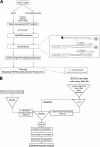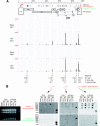Analysis of HIV-1 expression level and sense of transcription by high-throughput sequencing of the infected cell
- PMID: 21507965
- PMCID: PMC3126515
- DOI: 10.1128/JVI.00252-11
Analysis of HIV-1 expression level and sense of transcription by high-throughput sequencing of the infected cell
Abstract
Next-generation sequencing offers an unprecedented opportunity to jointly analyze cellular and viral transcriptional activity without prerequisite knowledge of the nature of the transcripts. SupT1 cells were infected with a vesicular stomatitis virus G envelope protein (VSV-G)-pseudotyped HIV vector. At 24 h postinfection, both cellular and viral transcriptomes were analyzed by serial analysis of gene expression followed by high-throughput sequencing (SAGE-Seq). Read mapping resulted in 33 to 44 million tags aligning with the human transcriptome and 0.23 to 0.25 million tags aligning with the genome of the HIV-1 vector. Thus, at peak infection, 1 transcript in 143 is of viral origin (0.7%), including a small component of antisense viral transcription. Of the detected cellular transcripts, 826 (2.3%) were differentially expressed between mock- and HIV-infected samples. The approach also assessed whether HIV-1 infection modulates the expression of repetitive elements or endogenous retroviruses. We observed very active transcription of these elements, with 1 transcript in 237 being of such origin, corresponding on average to 123,123 reads in mock-infected samples (0.40%) and 129,149 reads in HIV-1-infected samples (0.45%) mapping to the genomic Repbase repository. This analysis highlights key details in the generation and interpretation of high-throughput data in the setting of HIV-1 cellular infection.
Figures



References
-
- Bayne E. H., White S. A., Allshire R. C. 2007. DegrAAAded into silence. Cell 129:651–653 - PubMed
Publication types
MeSH terms
Substances
LinkOut - more resources
Full Text Sources

